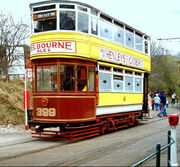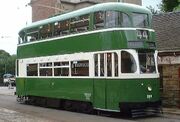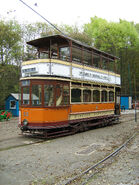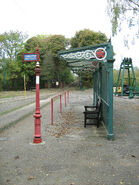| This article needs additional citations for verification. Please help improve this article by adding citations to reliable sources. Unsourced material may be challenged and removed. (January 2010) |

Crich features working trams in a traditional street setting. This 1931 Leeds tram is about to pass under the historic Bowes-Lyon Bridge
The National Tramway Museum, at Crich, ( listen (help·info)) in Derbyshire, England, is situated within Crich Tramway Village, a period village containing a pub, cafe, old-style sweetshop, including the tram depots. The village is also home to the Eagle Press, a small museum dedicated to Letterpress Printing including an 1859 Columbian printing press. The museum's collection of trams runs through the village setting. Visitors are transported one mile out into the countryside and back, aboard the varied fleet of trams.
The trams at Crich mostly ran along the streets of cities in United Kingdom before the 1960s, with some trams rescued and restored (even from other countries) as the systems closed. The town of Matlock is close by and the nearest train service is from Whatstandwell railway station on the Derwent Valley Line (Derby-Matlock line), with a steep walk up to the museum at the top of the hill.
History of the museum[]

A 1925 Leeds tram at Victoria Park, at the entrance to the Village
Decline of tramways[]
[1] Most of the tram networks, with a few exceptions (notably Blackpool) closed before the 1960s. The last to close was Glasgow Corporation Tramways in 1962, a tramway well represented at the Museum. There has been a recent revival with new networks such as the Croydon Tramlink, Sheffield Supertram, Midland Metro, Edinburgh Trams, Manchester Metrolink and the nearby Nottingham Express Transit being built and extended.
History of the site[]

A 1936 Liverpool streamlined tram outside the reconstructed Derby Assembly Rooms at Crich Town End
George Stephenson, the great railway pioneer, had a close connection with Crich and the present (2008) tramway follows part of the mineral railway he built to link the quarry with Ambergate.
While building the North Midland Railway from Derby to Rotherham and Leeds, Stephenson had found rich coal seams in the Clay Cross area and he saw a new business opportunity. Crich was already well known for the quality of the limestone and Stephenson recognised that he could use the local coal and limestone to produce burnt lime for agricultural purposes, and then utilise the new railway to distribute it. Cliff Quarry, where Crich Tramway Village is now located, was acquired by Stephenson's company and to link the quarry with the limekilns he had built alongside the new North Midland Railway at Ambergate, Stephenson constructed a metre gauge line - apparently the first metre gauge railway in the world. Stephenson was born in Wylam in Northumberland in 1781, but he lived the last 10 years of his life in Chesterfield, often bringing visitors to Crich to see the mineral railway and take refreshment in one of the village inns. He died in 1848 and is buried in Holy Trinity Church, Chesterfield. Stephenson's railway soldiered on for many years.
Tramway Museum Society[]
In the period after the Second World War, when most of the remaining British tramways were in decline or actually closing, the first event in the history of the National Tramway Museum took place. A group of enthusiasts on a farewell tour of Southampton Tramways in August 1948 decided to purchase one of the open top trams on which they had ridden. For the sum of £ 10 they purchased number 45 – now the doyenne of the tramcar collection at the Crich Tramway Village. From this act of faith – at the time there were no heritage railways, museums tended to be of dull glass cases and the idea of amateurs running a tramway or railway seemed incredible – grew the idea of a working museum devoted to operating tramcars. From the original group developed the Tramway Museum Society, established in 1955, incorporated as a company limited by guarantee in 1962, and recognised as an educational charity in 1963. Over the years, the Society has drawn its members from men and women of all age groups and all sectors of the community, working together in different ways to create the tramway museum.
Acquisition of the site[]
After a sustained search across the country, in 1959 the Society's attention was drawn to the then derelict limestone quarry at Crich in Derbyshire, from which members of the Talyllyn Railway Preservation Society were recovering track from Stephenson's mineral railway for their pioneering preservation project in Wales. After a tour of the quarry, members of the Society agreed to lease – and later purchase – part of the site and buildings. Over the years, by the efforts of the society members, a representative collection of tramcars was brought together and restored, tramway equipment was acquired, a working tramway was constructed and depots and workshops were built. Recognising that tramcars did not operate in limestone quarries, the society agreed in 1967 to create around the tramway the kind of streetscape through which the trams had run and thus the concept of the Crich Tramway Village was born. Members then turned their attention to collecting items of street furniture and even complete buildings, which were then adapted to house the Museum's collections of books, photographs and archives.
Recognition[]
The vision of the pioneering members who established the Museum, and the work of members who turned the vision into a reality was recognised formally in 1995, when the Secretary of State for National Heritage announced that the Museum was included in the first 26 museums which had been designated because of the outstanding nature of their collections.
Funding[]
In recent years the work of the Society Members and the income earned from visitors has been supplemented by much appreciated grants from the Heritage Lottery Fund, the Designation Challenge Fund of the Museums, Libraries and Archives Council and the DEFRA Aggregates Levy Sustainability Fund. The Crich Tramway Village is however still an independent charity, which receives no core funding from the state or local government and it could not function without the ongoing voluntary contribution made by members of the Tramway Museum Society.
Timeline[]
- 1963 - First horse tram service
- 1964 - First electric tram service
- 1969 - Opening of purpose built workshops
- 1975 - HRH The Duke of Gloucester become Patron of the Society
- 1978 - Opening of scenic tramway to Wakebridge by Secretary of State for Employment
- 1982 - First phase of museum library opened
- 1985 - Museum loans trams to Blackpool for Electric Tram Centenary
- 1988 - Museum loans trams for Glasgow Garden Festival
- 1990 - Museum loans trams for Gateshead Garden Festival
- 1991 - Exhibition Hall inaugurated
- 1992 - Bowes-Lyon Bridge opened by Minister of State for Transport
- 1997 - First AccessTram for visitors with disabilities
- 2002 - Opening of Workshop Viewing Gallery
- 2003 - Library Reading Room and Archives Store opened by HRH The Duke of Gloucester
- 2004 - Woodland Walk and Sculpture Trail inaugurated by the Dowager Duchess of Devonshire
- 2007 - Leeds 345 wins the Best Self-Propelled Vehicle in the Heritage Railway Association Carriage & Wagon Awards, after its three-year restoration and return to service in 2004
- 2010 - Opening of new "Century of Trams" exhibition in main Exhibition Hall
- 2011 - Opening of refurbished George Stephenson Workshop, which now contains an education suite on the ground floor and a brand new exhibition on the upper floor which connects over a bridge to the Workshop Gallery
Methods of current collection[]
The museum's overhead wire system has been built so that trams with any type of current collection can be used. The museum currently houses trams with trolley poles, bow collectors and pantographs.[2]
Other forms used to demonstrate how current can be collected:
- Conductors set in steel troughs under the roadway, as used in Blackpool, and represented in Crich with Number 4.
- The stud contact system, as demonstrated with a dummy stud between the rails in the yard. This is the only known example of this form remaining, and is from Wolverhampton.
Events[]
The museum hold a number of themed events throught the year that have people in costume and historic vehicle from a particular era visiting. The 1940s weekends being particularly popular, with both people who like to dress in the 1940s style and military vehicle enthusiasts turning up. the museum being deked out as a wartime scene with check points airraid warning signs and taped up windows and 1940 music playing.
Tramcar fleet[]

East Berlin Tram during Red October Day 2007, one of the many themed events at Crich
- Main article: Tramcars of the National Tramway Museum
The museum has over 60 tramcars from locations such as Berlin, Blackpool, Chesterfield, Den Haag, Derby, Douglas, Dundee, Edinburgh, Gateshead, Glasgow, Grimsby, Halle, Howth, Johannesburg, Leeds, Leicester, Liverpool, London, New York, Newcastle-upon-Tyne, Oporto, Paisley, Prague, Sheffield, Southampton and Sydney.
As of January 2010[update], there were approximately seventeen in a day-to-day operational condition, with the remainder of the collection on static display or in store.
Gallery[]
See also[]
- Beamish Museum
- Blackpool tramway
- East Anglia Transport Museum
- Light Rail Transit Association
- Maley & Taunton
- Scottish Tramway and Transport Society
- Summerlee Heritage Park (Coatbridge)
- The Trolleybus Museum at Sandtoft
References[]
- ↑ (Yearly) Crich Tramway Village Guidebook. Crich Tramway Village.
- ↑ "Methods of Current Collection".
External links[]
- Official website
- Topical pictures of the Museum
- The London County Council Tramways Trust —- responsible for the restoration of London nos. 1, 106, 159, 1622
- The Tram Centre —- all sorts of information can be found here on all types of trams
- Photographs and Information from Strolling Guides
- Pictures from Crich (Danish Tramway website)
Coordinates: 53°05′21″N 1°29′11″W / 53.08930°N 1.48632°W
| |||||||||||||||||||||||
| ||||||||||||||||||||||||||
| ||||||||||||||
| |||||||||||||||||||||||||||||
| This page uses some content from Wikipedia. The original article was at National Tramway Museum. The list of authors can be seen in the page history. As with Tractor & Construction Plant Wiki, the text of Wikipedia is available under the Creative Commons by Attribution License and/or GNU Free Documentation License. Please check page history for when the original article was copied to Wikia |







